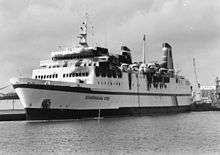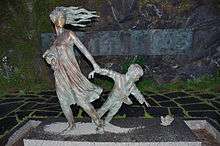MS Scandinavian Star
 Scandinavian Star after the disaster | |
| History | |
|---|---|
| Name: | MS Massalia |
| Owner: | Nouvelle Compagnie de Paquebots (Paquet) |
| Route: | Marseille – Málaga – Casablanca |
| Builder: | Dubigeon-Normandie |
| Yard number: | 124 |
| Launched: | 19 January 1971 |
| Completed: | 1971 |
| Identification: | IMO number: 7048219 |
| Name: | MS Stena Baltica |
| Owner: | Stena Cargo Line Ltd |
| Port of registry: |
Nassau, |
| Acquired: | 1 October 1983 |
| Fate: | Sold |
| Name: | MS Island Fiesta |
| Owner: | Stena Cargo Line Ltd |
| Port of registry: |
Nassau, |
| Acquired: | November 1984 |
| Fate: | Chartered |
| Name: | MS Scandinavian Star |
| Operator: | Scandinavian World Cruises |
| Port of registry: |
Nassau, |
| Route: |
St. Petersburg, Florida / Tampa, Florida – Cozumel, |
| Acquired: | December 1984 |
| Out of service: | 1990 |
| Fate: | Sold |
| Name: | MS Scandinavian Star |
| Owner: | Vognmandsruten |
| Operator: | DA-NO Linjen |
| Route: |
Oslo, |
| Acquired: | 1990 |
| Name: | MS Candi |
| Owner: | Vognmandsruten |
| Acquired: | 1990 |
| Out of service: | 1990 |
| Fate: | Laid up (1990–1994) |
| Name: | MS Regal Voyager |
| Owner: | International Shipping Partners |
| Acquired: | February 1994 |
| Out of service: | 1997 |
| Fate: | Sold |
| Name: | MS Regal V |
| Acquired: | 2004 |
| Fate: | Scrapped |
| General characteristics | |
| Tonnage: | 10513 GRT |
| Length: | 142.24 m (466.7 ft) |
| Beam: | 22.2 m (73 ft) |
| Draft: | 5.5 m (18 ft) |
| Installed power: | 2 * 16 cylinder Pielstick diesel, 11.770 kW |
| Speed: | 20 knots (37 km/h; 23 mph) |
MS Scandinavian Star, originally named MS Massalia and also known by other names (see infobox), was a car and passenger ferry built in France in 1971. The ship was set on fire in 1990, killing 159 people.[1]
History
M/S Massalia was built by Dubigeon-Normandie S.A. in 1971 and delivered to Compagnie de Paquebots who put her on the route Marseille–Málaga–Casablanca and also cruises in the Mediterranean Sea. In 1984 she was owned by a number of companies and named Stena Baltica, Island Fiesta and finally Scandinavian Star, a name given to her by Scandinavian World Cruises who chartered the ship and put her on cruises between St. Petersburg, Florida and Tampa, Florida to Cozumel, Mexico.
Fire
In 1990, the Scandinavian Star was sold to Vognmandsruten and put into service on DA-NO Linjen's route between Oslo, Norway, and Frederikshavn, Denmark. As the ship had been converted from a casino ship to a passenger ferry, a new crew needed to be trained and were given just ten days to learn new responsibilities. Master mariner Captain Emma Tiller, interviewed for the National Geographic Channel's documentary series Seconds from Disaster, stated that six to eight weeks would be a reasonable period to train a crew for a ship of the Star's size. The documentary went on to explain that many of the crew could not speak English, Norwegian or Danish, thus further reducing the effectiveness of the response to the emergency. The insurance company Skuld's technical leader, Erik Stein, had inspected the ship shortly before, and had declared the fire preparedness deficient, for among other reasons because of defective fire doors.[2]
During the night of 7 April 1990, at about 2 a.m. local time, fire broke out in an unoccupied portion of Deck 3 within the passenger section of the ship. The subsequent investigation found no natural origin for the second fire and concluded it was deliberately set. A previous fire nearby started about 15 minutes earlier, and was discovered by a passenger and extinguished, and may have been started deliberately. Although the bulkheads were made of steel structure with asbestos wall boards, a melamine resin laminate was used as a decorative covering and proved extremely flammable in subsequent testing, spreading fire throughout Deck 3. The burning laminates produced toxic hydrogen cyanide and carbon monoxide gases. The fire then spread to Deck 4 and Deck 5.
When the captain learned of the fire, he attempted to close the bulkhead fire doors on Deck 3. The fire doors were not configured for fully automatic closing and did not respond since emergency alarms near the doors had not been manually triggered by passengers or crew. A vehicle storage area ventilated by large fans to remove exhaust fumes was also located nearby, and the fans pulled air through an improperly secured fire door and caused rapid fire progress from Deck 3 through Deck 4 and Deck 5 via stairways located on either end. The captain later ordered his crew to turn off the ventilation system when he realized it was feeding the fire, and an unintended result was that smoke was able to enter passenger cabins via the door vents. Some tried to seek refuge from the smoke in areas such as closets and bathrooms, but were eventually overcome by smoke. Those who tried to escape may have variously encountered thick smoke, confusing corridor layouts, and poorly trained crew members. The captain ordered the general alarms to be activated, told everyone to abandon ship, and sent out a mayday request. The captain and crew ultimately abandoned ship before all passengers were evacuated, leaving many still on board the burning ship even after it was towed to the harbor.
Investigators proposed several reasons for why many passengers did not safely evacuate:
- Many people probably did not hear the alarms due to distance between their cabins and the alarms, and due to ordinary mechanical noise of the ship systems.
- Some people probably could not find their way out because of thick smoke obscuring the exit routes and signage.
- Burning melamine panels in the hallways produced poisonous hydrogen cyanide and carbon monoxide, causing rapid unconsciousness and death.
- Numerous Portuguese crew members did not speak or understand Norwegian, Danish or English, were unfamiliar with the ship, and had never practiced a fire drill. Only a few crew members even thought to put on breathing masks before entering smoke filled corridors.
- On Deck 5, where most passenger deaths occurred, the hallways were arranged in a layout that contained dead-ends and did not otherwise logically lead to emergency exits.
The ship was towed to Lysekil, Sweden, where the fire department suppressed the fire in 10 hours. 158 people, or approximately one-third of all passengers on board, died on the ship. Another victim died two weeks later from his injuries. 136 of those killed were Norwegian.
The Scandinavian Star had had another fire prior to 1990. On 15 March 1988, while sailing for SeaEscape on a Caribbean cruise, a fire started in the engine room when the ship was about 50 nautical miles (90 km) northeast of Cancun, Mexico. The ship was carrying 439 passengers and 268 crew members. The ship lost power and the emergency oxygen system malfunctioned, hampering the fire fighting crew's efforts. The inability of the crew members to communicate with each other and with passengers was a serious concern and created confusion during the fire fighting and evacuation activities.[3]
Police investigation
A police investigation initially cast suspicion on a Danish truck driver, previously convicted for arson.[4]
A 2013 report prepared by a private group called "Stiftelsen Etterforskning Av Mordbrannen Scandinavian Star" (Norwegian for "Foundation for Arson Investigation Scandinavian Star") claims however that the suspected truck driver was killed by smoke resulting from one of the first two fires by as much as 24 hours prior to the last fire being started.[5] The 2013 report claims that nine members of the crew, having joined the ship in Tampa, were most likely responsible for all of the six fires started on the Scandinavian Star. This also included smashing open the supposedly break-safe windows of the ship to fan the fires. The arsonists in the crew also sabotaged the fire crew's efforts to put out the fire. The likely motive was insurance fraud, as the ship was insured for twice its value shortly before the fire broke out. The theory is that these nine were hired by the ship's owners to ignite the fire. Ownership of the vessel at the time of the fire proved difficult to establish. The name of the nine suspected members of the crew are pending release during further investigation in Norway.[6]
After the 2013 report, the police created a work group which will be active until the end of 2013. The work group will come with a recommendation whether a new investigation should be opened.[7]
In March 2015 the Norwegian Storting decided to remove the prescription rule for arson, such that criminal investigation and prosecution remain possible.[8]
Salvage
The burnt ship was towed to Copenhagen, Denmark on 18 April 1990, arriving two days later[9] and remaining there for several months. On 11 August 1990 she was towed to the United Kingdom, first arriving at Hull[10] before moving onto Southampton on the 10th of September 1990; the vessel was renamed Candi by simply painting over part of the original name.
In February 1994 she was sold on auction to International Shipping Partners.[11] She was renamed Regal Voyager, sent to Italy for rebuilding and later chartered to Comarit Ferries and put on the route between Tangier and Port Vendres.
In 1997 she was registered for St. Thomas Cruises and put on a route between Port Isabel and Puerto Cortés for Isabel Cortes Ferry Service. Chartered to Ferries del Caribe in 1999 and put on the route Santo Domingo – San Juan. The ship was laid up in South Carolina in 2003, then sold to Indian shipbreakers in 2004 and renamed to Regal V. She arrived at Alang on 14 May 2004, and the work to get her broken up started five days later.
Memorial

On 7 April 2006, a memorial was inaugurated in Oslo, near the Akershus Fortress. It features a mother with her child and a large commemorative plaque with the names of all the victims of the fire.[12]
See also
Notes
- ↑ Solheim, T.; Lorentsen, M.; Sundnes, P.K.; Bang, G. & Bremnes, L. (1992): The “Scandinavian Star” ferry disaster 1990 – a challenge to forensic odontology. International Journal of Legal Medicine 104: 339-345.
- ↑ https://politiken.dk/magasinet/feature/ECE2848881/manden-der-ikke-ville-godkende-scandinavian-star/
- ↑ NTSB report on the fire, and from the U.S. Coast Guard radioman who copied and worked the Search and Rescue case.
- ↑ Scandinavian Star gjennomgang: Mistenkte var død ett døgn før siste brann, vg.no; accessed 7 April 2015.(Norwegian)
- ↑ Scandinavian Star gjennomgang: Mistenkte var død ett døgn før siste brann, vg.no; accessed 7 April 2015.(Norwegian)
- ↑ Fagfolk: - Mannskap stiftet Scandinavian Star-brann - Scandinavian Star, VG.no; accessed 7 April 2015.(Norwegian)
- ↑ Politiet vil granske «Scandinavian Star»-saken, Aftenposten.no; accessed 7 April 2015.(Norwegian)
- ↑ Storting, Representantforslag om fjerning av foreldingsfristen for brot på straffelova § 148 første ledd første punktum andre straffalternativ (mordbrannparagrafen)
- ↑ "M/S MASSALIA 1971". Retrieved 24 April 2010.
- ↑ "SCANDINAVIAN STAR". 1990. Retrieved 24 April 2010.
- ↑ Asklander, Micke. "M/S Massalia." (in Swedish). Retrieved 26 April 2012.
- ↑ "Scandinavian Star". 13 June 2009. Retrieved 24 April 2010.
External links
| Wikimedia Commons has media related to Scandinavian Star (ship, 1971). |
| ||||||||||||||